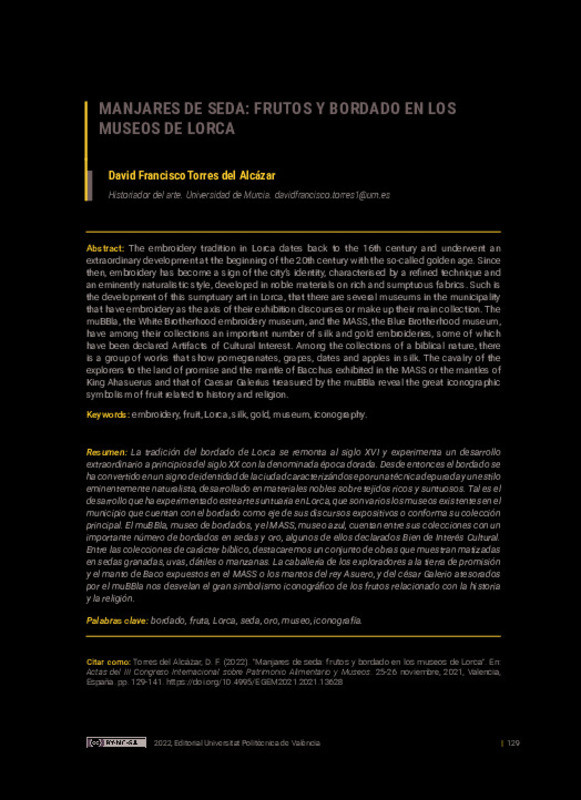JavaScript is disabled for your browser. Some features of this site may not work without it.
Buscar en RiuNet
Listar
Mi cuenta
Estadísticas
Ayuda RiuNet
Admin. UPV
Manjares de seda: frutos y bordado en los museos de Lorca
Mostrar el registro sencillo del ítem
Ficheros en el ítem
| dc.contributor.author | Torres Del Alcazar, David Francisco
|
es_ES |
| dc.coverage.spatial | east=-1.6968357; north=37.6735925; name=Lorca, Espanya | es_ES |
| dc.date.accessioned | 2022-07-21T09:34:11Z | |
| dc.date.available | 2022-07-21T09:34:11Z | |
| dc.date.issued | 2022-03-04 | |
| dc.identifier.isbn | 9788490489963 | |
| dc.identifier.uri | http://hdl.handle.net/10251/184603 | |
| dc.description.abstract | [EN] The embroidery tradition in Lorca dates back to the 16th century and underwent an extraordinary development at the beginning of the 20th century with the so-called golden age. Since then, embroidery has become a sign of the city’s identity, characterised by a refined technique and an eminently naturalistic style, developed in noble materials on rich and sumptuous fabrics. Such is the development of this sumptuary art in Lorca, that there are several museums in the municipality that have embroidery as the axis of their exhibition discourses or make up their main collection. The muBBla, the White Brotherhood embroidery museum, and the MASS, the Blue Brotherhood museum, have among their collections an important number of silk and gold embroideries, some of which have been declared Artifacts of Cultural Interest. Among the collections of a biblical nature, there is a group of works that show pomegranates, grapes, dates and apples in silk. The cavalry of the explorers to the land of promise and the mantle of Bacchus exhibited in the MASS or the mantles of King Ahasuerus and that of Caesar Galerius treasured by the muBBla reveal the great iconographic symbolism of fruit related to history and religion. | es_ES |
| dc.description.abstract | [ES] La tradición del bordado de Lorca se remonta al siglo XVI y experimenta un desarrollo extraordinario a principios del siglo XX con la denominada época dorada. Desde entonces el bordado se ha convertido en un signo de identidad de la ciudad caracterizándose por una técnica depurada y un estilo eminentemente naturalista, desarrollado en materiales nobles sobre tejidos ricos y suntuosos. Tal es el desarrollo que ha experimentado este arte suntuaria en Lorca, que son varios los museos existentes en el municipio que cuentan con el bordado como eje de sus discursos expositivos o conforma su colección principal. El muBBla, museo de bordados, y el MASS, museo azul, cuentan entre sus colecciones con un importante número de bordados en sedas y oro, algunos de ellos declarados Bien de Interés Cultural.Entre las colecciones de carácter bíblico, destacaremos un conjunto de obras que muestran matizadas en sedas granadas, uvas, dátiles o manzanas. La caballería de los exploradores a la tierra de promisión y el manto de Baco expuestos en el MASS o los mantos del rey Asuero y del césar Galerio atesorados por el muBBla nos desvelan el gran simbolismo iconográfico de la fruta relacionado con la historia y la religión. | es_ES |
| dc.format.extent | 13 | es_ES |
| dc.language | Español | es_ES |
| dc.publisher | Editorial Universitat Politècnica de València | es_ES |
| dc.relation.ispartof | Actas del III Congreso Internacional sobre Patrimonio Alimentario y Museos | |
| dc.rights | Reconocimiento - No comercial - Compartir igual (by-nc-sa) | es_ES |
| dc.subject | Museo | es_ES |
| dc.subject | Lorca | es_ES |
| dc.subject | Bordado | es_ES |
| dc.subject | Seda | es_ES |
| dc.subject | Fruta | es_ES |
| dc.subject | Oro | es_ES |
| dc.subject | Iconografía | es_ES |
| dc.subject | Embroidery | es_ES |
| dc.subject | Fruit | es_ES |
| dc.subject | Silk | es_ES |
| dc.subject | Gold | es_ES |
| dc.subject | Museum | es_ES |
| dc.subject | Iconography | es_ES |
| dc.title | Manjares de seda: frutos y bordado en los museos de Lorca | es_ES |
| dc.type | Capítulo de libro | es_ES |
| dc.type | Comunicación en congreso | es_ES |
| dc.identifier.doi | 10.4995/EGEM2021.2021.13628 | |
| dc.rights.accessRights | Abierto | es_ES |
| dc.description.bibliographicCitation | Torres Del Alcazar, DF. (2022). Manjares de seda: frutos y bordado en los museos de Lorca. En Actas del III Congreso Internacional sobre Patrimonio Alimentario y Museos. Editorial Universitat Politècnica de València. 129-141. https://doi.org/10.4995/EGEM2021.2021.13628 | es_ES |
| dc.description.accrualMethod | OCS | es_ES |
| dc.relation.conferencename | 3er Congreso Internacional sobre Patrimonio Alimentario y Museos | es_ES |
| dc.relation.conferencedate | Noviembre 25-26, 2021 | es_ES |
| dc.relation.conferenceplace | Valencia, España | es_ES |
| dc.relation.publisherversion | http://ocs.editorial.upv.es/index.php/EGEM/EGEM2021/paper/view/13628 | es_ES |
| dc.description.upvformatpinicio | 129 | es_ES |
| dc.description.upvformatpfin | 141 | es_ES |
| dc.type.version | info:eu-repo/semantics/publishedVersion | es_ES |
| dc.relation.pasarela | OCS\13628 | es_ES |








